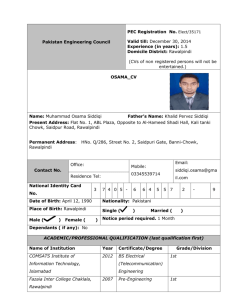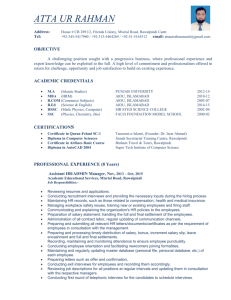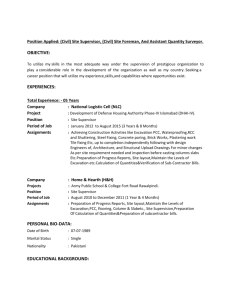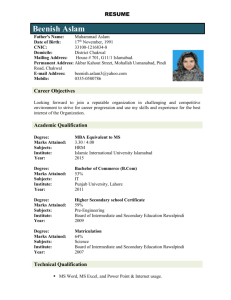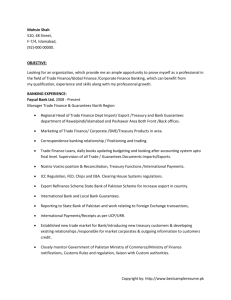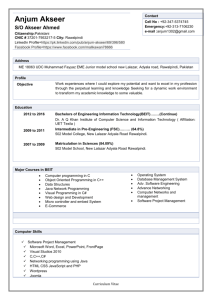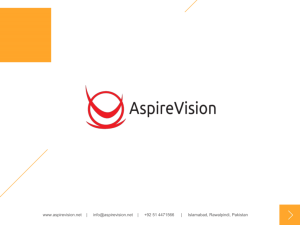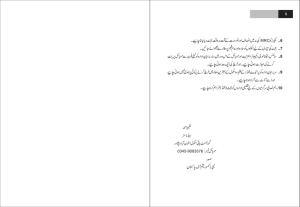Document 13309140
advertisement
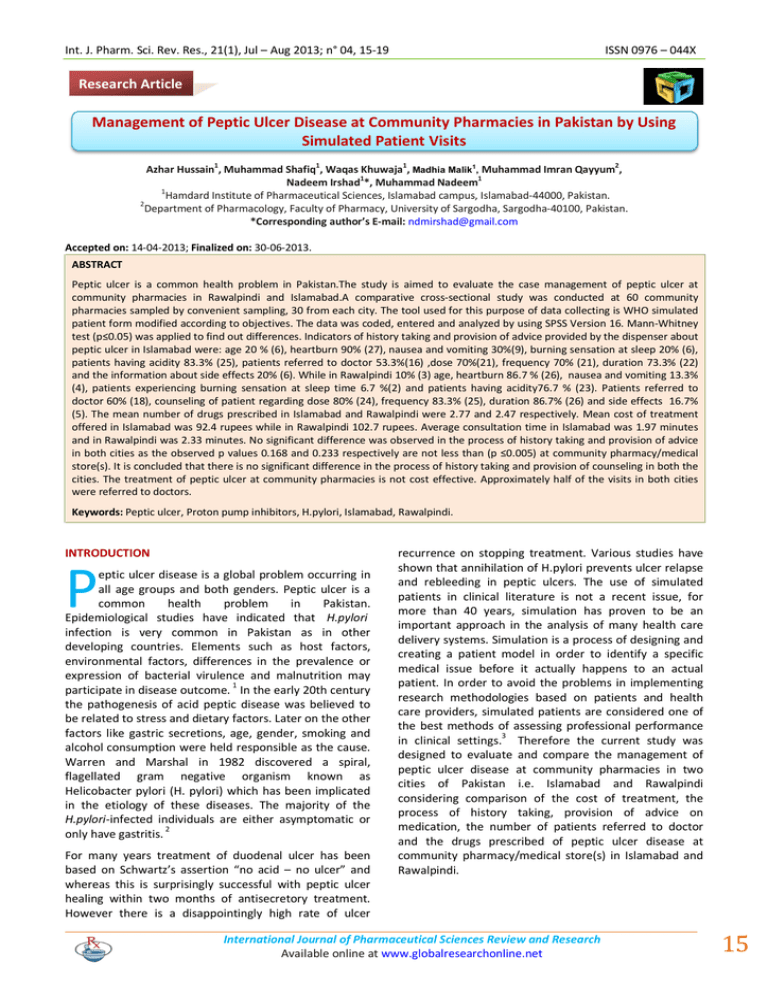
Int. J. Pharm. Sci. Rev. Res., 21(1), Jul – Aug 2013; n° 04, 15-19 ISSN 0976 – 044X Research Article Management of Peptic Ulcer Disease at Community Pharmacies in Pakistan by Using Simulated Patient Visits 1 1 1 2 Azhar Hussain , Muhammad Shafiq , Waqas Khuwaja , Madhia Malik1, Muhammad Imran Qayyum , 1 1 Nadeem Irshad *, Muhammad Nadeem 1 Hamdard Institute of Pharmaceutical Sciences, Islamabad campus, Islamabad-44000, Pakistan. 2 Department of Pharmacology, Faculty of Pharmacy, University of Sargodha, Sargodha-40100, Pakistan. *Corresponding author’s E-mail: ndmirshad@gmail.com Accepted on: 14-04-2013; Finalized on: 30-06-2013. ABSTRACT Peptic ulcer is a common health problem in Pakistan.The study is aimed to evaluate the case management of peptic ulcer at community pharmacies in Rawalpindi and Islamabad.A comparative cross-sectional study was conducted at 60 community pharmacies sampled by convenient sampling, 30 from each city. The tool used for this purpose of data collecting is WHO simulated patient form modified according to objectives. The data was coded, entered and analyzed by using SPSS Version 16. Mann-Whitney test (p≤0.05) was applied to find out differences. Indicators of history taking and provision of advice provided by the dispenser about peptic ulcer in Islamabad were: age 20 % (6), heartburn 90% (27), nausea and vomiting 30%(9), burning sensation at sleep 20% (6), patients having acidity 83.3% (25), patients referred to doctor 53.3%(16) ,dose 70%(21), frequency 70% (21), duration 73.3% (22) and the information about side effects 20% (6). While in Rawalpindi 10% (3) age, heartburn 86.7 % (26), nausea and vomiting 13.3% (4), patients experiencing burning sensation at sleep time 6.7 %(2) and patients having acidity76.7 % (23). Patients referred to doctor 60% (18), counseling of patient regarding dose 80% (24), frequency 83.3% (25), duration 86.7% (26) and side effects 16.7% (5). The mean number of drugs prescribed in Islamabad and Rawalpindi were 2.77 and 2.47 respectively. Mean cost of treatment offered in Islamabad was 92.4 rupees while in Rawalpindi 102.7 rupees. Average consultation time in Islamabad was 1.97 minutes and in Rawalpindi was 2.33 minutes. No significant difference was observed in the process of history taking and provision of advice in both cities as the observed p values 0.168 and 0.233 respectively are not less than (p ≤0.005) at community pharmacy/medical store(s). It is concluded that there is no significant difference in the process of history taking and provision of counseling in both the cities. The treatment of peptic ulcer at community pharmacies is not cost effective. Approximately half of the visits in both cities were referred to doctors. Keywords: Peptic ulcer, Proton pump inhibitors, H.pylori, Islamabad, Rawalpindi. INTRODUCTION P eptic ulcer disease is a global problem occurring in all age groups and both genders. Peptic ulcer is a common health problem in Pakistan. Epidemiological studies have indicated that H.pylori infection is very common in Pakistan as in other developing countries. Elements such as host factors, environmental factors, differences in the prevalence or expression of bacterial virulence and malnutrition may participate in disease outcome. 1 In the early 20th century the pathogenesis of acid peptic disease was believed to be related to stress and dietary factors. Later on the other factors like gastric secretions, age, gender, smoking and alcohol consumption were held responsible as the cause. Warren and Marshal in 1982 discovered a spiral, flagellated gram negative organism known as Helicobacter pylori (H. pylori) which has been implicated in the etiology of these diseases. The majority of the H.pylori-infected individuals are either asymptomatic or only have gastritis. 2 For many years treatment of duodenal ulcer has been based on Schwartz’s assertion “no acid – no ulcer” and whereas this is surprisingly successful with peptic ulcer healing within two months of antisecretory treatment. However there is a disappointingly high rate of ulcer recurrence on stopping treatment. Various studies have shown that annihilation of H.pylori prevents ulcer relapse and rebleeding in peptic ulcers. The use of simulated patients in clinical literature is not a recent issue, for more than 40 years, simulation has proven to be an important approach in the analysis of many health care delivery systems. Simulation is a process of designing and creating a patient model in order to identify a specific medical issue before it actually happens to an actual patient. In order to avoid the problems in implementing research methodologies based on patients and health care providers, simulated patients are considered one of the best methods of assessing professional performance in clinical settings.3 Therefore the current study was designed to evaluate and compare the management of peptic ulcer disease at community pharmacies in two cities of Pakistan i.e. Islamabad and Rawalpindi considering comparison of the cost of treatment, the process of history taking, provision of advice on medication, the number of patients referred to doctor and the drugs prescribed of peptic ulcer disease at community pharmacy/medical store(s) in Islamabad and Rawalpindi. International Journal of Pharmaceutical Sciences Review and Research Available online at www.globalresearchonline.net 15 Int. J. Pharm. Sci. Rev. Res., 21(1), Jul – Aug 2013; n° 04, 15-19 MATERIALS AND METHODS This study explores the case management of Peptic Ulcer at community pharmacies in Pakistan by using simulated patient visits. This chapter consists of an outline of the methodology used in this study. Study Design A comparative cross-sectional (qualitative) study was designed to assess the case management of peptic ulcer at community pharmacies. Study Settings This study has been conducted in Islamabad and Rawalpindi. This setting was selected because of ease in data collection as both cities are comparable in practices at community pharmacies. List of registered pharmacies in Islamabad & Rawalpindi was used to select the community pharmacy.30 pharmacies from each city i.e. Islamabad and 30 pharmacies from Rawalpindi were selected. ISSN 0976 – 044X provision of advice (counseling) and classes of drugs prescribed. Mann-Whitney Test was applied to find out the significant differences and probability values were thus obtained. RESULTS The table (1) shows the different numbers and percentages of the indicators used in the process of history taking. The different indicators of history taking inquired by the respondents at community pharmacy/medical store located in Islamabad were: age of the patient 20%(6), patients having heartburn 90%(27), patients having nausea and vomiting 30%(9), patients experiencing burning sensation at sleep time20%(6), patients having acidity 83.3%(25) and number of patients referred to doctor 40%(12). While in Rawalpindi 10%(3) age of the patient, patients having heartburn 86.7 %(26), patients having nausea and vomiting 13.3%(4), patients experiencing burning sensation at sleep time 6.7 %(2) and patients having acidity76.7 %(23). Data Collection Table 1: History taking by respondents at community pharmacy Data was collected prospectively from 60 community pharmacies with 30 from each city of Pakistan i.e. Islamabad and Rawalpindi were visited and data was collected during months of September and October. Indicator Community pharmacies of cities Rawalpindi Islamabad 10% (3) 20% (6) Patients having heartburn asked 86.7% (26) 90%(27) Patients having nausea and vomiting asked 13.3%(4) 30%(9) Patients having burning sensation at sleep time asked 6.7%(2) 20.0%(6) 76.7%(23) 83.3%(25) Age of patient asked Sampling Procedure The sampling technique is non-probability convenient sampling. Ease of access was the basis of sampling and data collection along with financial constraints. Community pharmacies were visited by the simulated patients for seeking the treatment. The principle investigators themselves acted as simulated patients and visited the community pharmacies of the two cities i.e. Islamabad and Rawalpindi. Patients asked Inclusion criteria Only the registered medical stores and pharmacies of Islamabad and Rawalpindi were used to collect the data. Data Collection Tool Simulated visit surveys are used to gather quantitative information; they are usually carried out with samples of thirty or more health providers as per guidelines from INRUD Module of World Health Organization. This form is subdivide into 7 main subheadings which include assessor name, date, outlet name, time and type of outlet, assessment by the personnel made about the patient, diagnosis, numbers of drugs prescribed, cost per patient, average consultation time. WHO Simulated Patient Visit Form is modified according to objectives. This form was a submitted to our supervisors for validation. Data Analysis After collection of data, suitable and appropriate variables were entered and analyzed with SPSS (Statistical Package for the Social Sciences) version 16. Cross Tabs (frequencies) were run for parameters like history taking, having acidity The table (2) shows different numbers and percentages of the indicators used in the process of giving advice and drug use. The different indicators of advice and drug use given by the respondents at community pharmacy/ medical store located in Islamabad were: dose of drug 70 %(21), frequency of use 70%(21), duration of use 73.3%(22), giving information on possible side effects 20%(6) and referred to doctor 53.3%(16). While on other hand at the community pharmacy/medical store of Rawalpindi indicators were: dose of drug 80%(24), frequency of use 83.3%(25), duration of use 86.7%(26), giving information on possible side effects 16.7%(5) and referred to doctor 60%(18). The mean number of drugs prescribed by the respondents at community pharmacy/medical store(s) in Islamabad was 2.77(±0.817) while it was 2.47(±0.776) in Rawalpindi. Mean cost of treatment offered for peptic ulcer at community pharmacy/medical store in Islamabad was 92.4(±59.1) rupees while in Rawalpindi it was International Journal of Pharmaceutical Sciences Review and Research Available online at www.globalresearchonline.net 16 Int. J. Pharm. Sci. Rev. Res., 21(1), Jul – Aug 2013; n° 04, 15-19 ISSN 0976 – 044X 102.7(±105.7) rupees. Average consultation time in Islamabad was 1.97(±1.189) minutes on other hand in at community pharmacy/medical store(s) located in Rawalpindi was 2.33(±1.124) minutes (Tab. 3). Table 2: Provision of pharmacy/medical store Different classes of drugs prescribed for peptic ulcer patients at community pharmacy in Islamabad were; PPIs 53.34%(16), H2RA 16.67%(5), Antacids 63.34%(19), Motility enhancers 3.34%(1), Multivitamins 3.34%(1), Digestive enzyme preparations 13.34%(4) and NSAIDs 3.34%(1). Whereas in Rawalpindi; PPIs 66.67%(20), H2RA 13.3%(4), Antacids 46.67%(14), Antibiotics 6.67%(2), Motility enhancers 3.34%(1), Digestive enzyme preparations 0%(0) and NSAIDs 0%(0) as shown in Tab.5. at community Community pharmacies of cities Indicator No significant difference was observed in the process of history taking and provision of advice in both cities as the observed p values 0.168 and 0.233 respectively are not less than (p ≤0.005) at community pharmacy/medical store(s) (Tab. 4). advice Rawalpindi Islamabad Dose of drug 80%(24) 70%(21) Frequency 83.3%(25) 70%(21) Duration of use 86.7%(26) 73.3%(22) Side effects 16.7%(5) 20%(6) Referred to doctor 60%(18) 53.3%(16) Table 3: Average number of drugs prescribed, mean cost of drugs, average consultation time No. of drugs prescribed Mean cost of drugs Average consultation time Mean (±S.D) Mean (±S.D) Mean (±S.D) Islamabad 2.77(0.817) 92.40(59.1) 1.97min(1.189) Rawalpindi 2.47(0.776) 102.7(105.7) 2.33min(1.124) City Table 4: Comparison of process of history taking and provision of advice at communitypharmacies in two cities Case management scale History taking provision Variables Cities Advice provision n U Mean rank P value n U Mean rank P Value Islamabad 30 360.500 27.52 0.168 30 377.00 32.97 0.233 Rawalpindi 30 360.500 33.48 0.168 30 377.00 28.03 0.233 Table 5: Different classes of drugs prescribed in both cities Facility Rawalpindi Islamabad PPIsN (%) 20(66.67%) 16(53.34%) H2RA N (%) 4(13.3%) 5(16.67%) Antacids N (%) 14(46.67%) 19(63.34%) Antibiotics N (%) 2(6.67%) 1(3.34%) Motility enhancers N (%) 1(3.34%) 1(3.34%) Multivitamins N (%) 1(3.34%) 1(3.34%) Digestive Enzyme preparations n (%) 0(0%) 4(13.34%) NSAIDs N (%) 0(0%) 1(3.34%) International Journal of Pharmaceutical Sciences Review and Research Available online at www.globalresearchonline.net 17 Int. J. Pharm. Sci. Rev. Res., 21(1), Jul – Aug 2013; n° 04, 15-19 DISCUSSION Community pharmacies are the healthcare and treatment centers for majority of the people in Pakistan. The economic benefits and the ease of availability are the major reasons for this choice. But unfortunately majority of these people are mishandled and misguided by the personnel present in these facilities and the level of healthcare is inadequate and substandard. This scenario is the outcome of the unavailability of the qualified, trained and technical staff. The overall knowledge and training of dispensers working at community pharmacies is inadequate in Pakistan. Many patients suffering from a variety of diseases visit the community pharmacies for treatment. So simulated patient (standard patient) visit is used in order to measure the management of different diseases carried out at community pharmacies by different personnel working at these premises. In order to avoid the problems in implementing research methodologies based on patients and health care providers, simulated patients are considered one of the best methods of assessing professional performance in clinical settings. The use of a simulated patient technique to assess respondent´s behavior is well documented and widely used in the medical field. In this method, a research assistant, who has been prepared in advance to present a standardized complaint, visits a health facility or pharmacy seeking treatment. The objective of this simulated visit is to determine how providers will react to this fixed scenario: what questions they ask, examinations they carry out, treatments they recommend, and what advice they give. Peptic ulcer is a common health problem in Pakistan. So in order to measure the case management of peptic ulcer at community pharmacy/medical(s) in Pakistan, we carried out the simulated patient visits at community pharmacies in Islamabad and Rawalpindi. We compared the management of the disease in the two cites at the same time. The facilities were visited by the principal investigators themselves acted as simulated patients. Then data was collected, analyzed and results were extracted. If we consider the process of history taking we come to know that higher number of respondents at community pharmacy/medical store(s) in Islamabad asked the symptoms of the disease as compared to Rawalpindi. However the number of patients referred to the doctor, average cost per prescription, average consultation time and extent of counseling regarding the use of drugs were higher in Rawalpindi as compared to Islamabad. We might find different reasons behind this attitude of the respondents when these indicators are discussed separately. Talking about the process of history taking at community pharmacy/medical store(s) in Islamabad, the probable reasons might be relatively better qualification of the respondents, the government checks/regulations and the area being the capital territory. As Islamabad city is more developed than Rawalpindi, the community pharmacy/medical store(s) owners prefer to hire the relatively qualified, trained and technical personnel, so ISSN 0976 – 044X they do their job in a better way. Also the overall higher living standards of in the city compel the community pharmacy/medical store(s) administration to comply with standards. Although the average number of drugs per prescription is higher in Islamabad but the extent of provision of counseling regarding dose, duration of use and the frequency was higher in Rawalpindi as compared to Islamabad. This also correlates with the higher average cost per prescription and higher average consultation time in Rawalpindi. The frequency of the drug prescribed per prescription was higher in Rawalpindi that makes the cost higher. The principal investigators showed apprehensions regarding the long duration of use along with higher cost therefore the respondents took more time in describing the dose and duration of drug use. The number of patients referred to doctor is higher in Rawalpindi along with the prescribing trend. However in Islamabad more number of patients was referred without prescribing any drug. This can be due to greater awareness of the respondents. Again the relative strict government checks put a limitation describing this practice. The case management observed was more appropriate in the developed areas of both cities such as in F-8 and F-10 sector of Islamabad, the simulated client was directly referred to the doctor without prescribing any drugs. No significant difference was observed in the process of history taking and provision of advice in both cities as the observed p values 0.168 and 0.233 respectively are not less than (p ≤0.05). It means that the process of history taking and provision of advice was more or less same at the community pharmacy/medical store(s) in both cities. As both the cities are big and developed, the caliber of personnel at the facilities is more or less same therefore the results are nonsignificant. Another possible reason behind this practice may be the qualification and professional training of personnel that is not markedly different in both cities. CONCLUSION This study shows that there is no marked difference in the case management approach of peptic ulcer in Islamabad and Rawalpindi, the overall practice is wrong. The persons working at pharmacies are improperly trained and unaware regarding the sale of prescription drugs to the patients. The patients are prescribed and advised instead of being referred to physician for complete and proper checkup, so that the major hazard could be prevented which in many cases can be lethal if not handled and managed properly. The prescribing is irrational at the community pharmacy/medical store(s) which in turn puts economic burden on the patient as the treatment offered is of no use in the long run. Proton pump inhibitors which are relatively expensive, makes the highest percentage of drugs prescribed. So the overall treatment of peptic ulcer at community pharmacy is not cost effective. International Journal of Pharmaceutical Sciences Review and Research Available online at www.globalresearchonline.net 18 Int. J. Pharm. Sci. Rev. Res., 21(1), Jul – Aug 2013; n° 04, 15-19 REFERENCES 1. Ahmed W, Qureshi H, Alam SE, Zuberi SJ: Pattern of duodenal ulcer in Karachi. J Pak Med Assoc, 40(9), 1990, 212-5. ISSN 0976 – 044X 3. Chua, Siang S; Ramachandran, Devi C; Paraidathathu, Thomas T. Response of community pharmacists to the presentation of back pain: a simulated patient study. International Journal of Pharmacy Practice, 14 (3), 2006, 171-178. 2. Marshall BJ, Warren JR. Unidentified curved bacilli in the stomach of patients with gastritis and peptic ulceration. Lancet, 16, 1984, 1311-5. Source of Support: Nil, Conflict of Interest: None. Corresponding Author’s Biography: Mr Nadeem Irshad Mr Nadeem Irshad graduated from Hamdard Institute of Pharmaceutical Sciences, Islamabad campus and Post graduated from University of Sargodha, Sargodha, Pakistan. At post graduation level taken specialization in pharmacology, completed master thesis in “Study of hypoglycaemic and hypolipidaemic effects of Canscora decussata extracts/fractions in normal and alloxan-induced diabetic rabbits”. Currently working as Lecturer at Hamdard Institute of Pharmaceutical Sciences, Islamabad Campus. International Journal of Pharmaceutical Sciences Review and Research Available online at www.globalresearchonline.net 19
